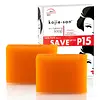What's inside
What's inside
 Key Ingredients
Key Ingredients

 Benefits
Benefits

 Concerns
Concerns

 Ingredients Side-by-side
Ingredients Side-by-side

Cocos Nucifera Oil
MaskingWater
Skin ConditioningSodium Hydroxide
BufferingParfum
MaskingKojic Acid
AntioxidantGlycerin
HumectantXanthan Gum
EmulsifyingCaprylyl Glycol
EmollientGlucose
HumectantChondrus Crispus
MaskingPhenoxyethanol
PreservativeEthylhexylglycerin
Skin ConditioningCocamide DEA
EmulsifyingParaffinum Liquidum
EmollientMelaleuca Alternifolia Leaf Oil
AntioxidantCI 15985
Cosmetic ColorantCI 19140
Cosmetic ColorantBHT
AntioxidantSodium Lauroyl Isethionate
CleansingStearic Acid
CleansingSodium Palmitate
CleansingWater
Skin ConditioningLauric Acid
CleansingSodium Isethionate
CleansingSodium Stearate
CleansingCocamidopropyl Betaine
CleansingParfum
MaskingSodium Palm Kernelate
CleansingButyrospermum Parkii Butter
Skin ConditioningGlycerin
HumectantSodium Chloride
MaskingZinc Oxide
Cosmetic ColorantPropylene Glycol
HumectantTetrasodium EDTA
Tetrasodium Etidronate
Emulsion StabilisingAlumina
AbrasiveBenzyl Alcohol
PerfumingBenzyl Salicylate
PerfumingButylphenyl Methylpropional
PerfumingCoumarin
PerfumingHexyl Cinnamal
PerfumingLimonene
PerfumingLinalool
PerfumingCI 15985
Cosmetic ColorantCI 19140
Cosmetic ColorantCI 77891
Cosmetic ColorantSodium Lauroyl Isethionate, Stearic Acid, Sodium Palmitate, Water, Lauric Acid, Sodium Isethionate, Sodium Stearate, Cocamidopropyl Betaine, Parfum, Sodium Palm Kernelate, Butyrospermum Parkii Butter, Glycerin, Sodium Chloride, Zinc Oxide, Propylene Glycol, Tetrasodium EDTA, Tetrasodium Etidronate, Alumina, Benzyl Alcohol, Benzyl Salicylate, Butylphenyl Methylpropional, Coumarin, Hexyl Cinnamal, Limonene, Linalool, CI 15985, CI 19140, CI 77891
 Reviews
Reviews

Ingredients Explained
These ingredients are found in both products.
Ingredients higher up in an ingredient list are typically present in a larger amount.
Ci 15985 is a dye made from petroleum. It is synthetically created and approved by the FDA for use in foods and cosmetics.
The color of this dye is orange/yellow.
This ingredient can be found in makeup, sun care, and skincare.
Learn more about CI 15985CI 19140 is also known as Tartrazine. Tartrazine is a synthetic dye used in cosmetics, foods, and medicine to add a yellow color.
Tartrazine is created from petroleum and is water-soluble.
Some people may experience allergies from this dye, especially asthmatics and those with an aspirin intolerance.
Learn more about CI 19140Glycerin is already naturally found in your skin. It helps moisturize and protect your skin.
A study from 2016 found glycerin to be more effective as a humectant than AHAs and hyaluronic acid.
As a humectant, it helps the skin stay hydrated by pulling moisture to your skin. The low molecular weight of glycerin allows it to pull moisture into the deeper layers of your skin.
Hydrated skin improves your skin barrier; Your skin barrier helps protect against irritants and bacteria.
Glycerin has also been found to have antimicrobial and antiviral properties. Due to these properties, glycerin is often used in wound and burn treatments.
In cosmetics, glycerin is usually derived from plants such as soybean or palm. However, it can also be sourced from animals, such as tallow or animal fat.
This ingredient is organic, colorless, odorless, and non-toxic.
Glycerin is the name for this ingredient in American English. British English uses Glycerol/Glycerine.
Learn more about GlycerinParfum is a catch-all term for an ingredient or more that is used to give a scent to products.
Also called "fragrance", this ingredient can be a blend of hundreds of chemicals or plant oils. This means every product with "fragrance" or "parfum" in the ingredients list is a different mixture.
For instance, Habanolide is a proprietary trade name for a specific aroma chemical. When used as a fragrance ingredient in cosmetics, most aroma chemicals fall under the broad labeling category of “FRAGRANCE” or “PARFUM” according to EU and US regulations.
The term 'parfum' or 'fragrance' is not regulated in many countries. In many cases, it is up to the brand to define this term.
For instance, many brands choose to label themselves as "fragrance-free" because they are not using synthetic fragrances. However, their products may still contain ingredients such as essential oils that are considered a fragrance by INCI standards.
One example is Calendula flower extract. Calendula is an essential oil that still imparts a scent or 'fragrance'.
Depending on the blend, the ingredients in the mixture can cause allergies and sensitivities on the skin. Some ingredients that are known EU allergens include linalool and citronellol.
Parfum can also be used to mask or cover an unpleasant scent.
The bottom line is: not all fragrances/parfum/ingredients are created equally. If you are worried about fragrances, we recommend taking a closer look at an ingredient. And of course, we always recommend speaking with a professional.
Learn more about ParfumWater. It's the most common cosmetic ingredient of all. You'll usually see it at the top of ingredient lists, meaning that it makes up the largest part of the product.
So why is it so popular? Water most often acts as a solvent - this means that it helps dissolve other ingredients into the formulation.
You'll also recognize water as that liquid we all need to stay alive. If you see this, drink a glass of water. Stay hydrated!
Learn more about Water